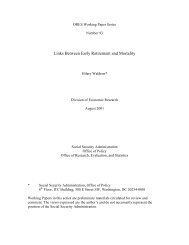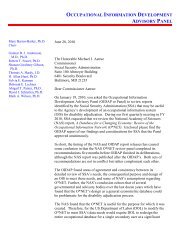Selected Abbreviations—continuedMINTPBGCPIMSSIPPSOISSASSIU.K.Modeling Income in the Near TermPension Benefit Guaranty CorporationPension Insurance Modeling SystemSurvey of Income and ProgramParticipationStatistics of Income<strong>Social</strong> <strong>Security</strong> AdministrationSupplemental <strong>Security</strong> IncomeUnited KingdomThese trends threaten to shake up the Americanretirement system as we know it because of vast differencesbetween DB and DC pension plans, includingdifferences in coverage rates within a firm, timing ofaccruals, investment and labor market risks, formsof payout, and effects on work incentives and labormobility. DB pensions are tied to employers who,consequently, bear the responsibility for ensuringthat employees receive pension benefits. In contrast,DC retirement assets are owned by employees who,therefore, bear the responsibility for their own financialsecurity.This article simulates how the shift from DB to DCpensions might affect the distribution of retirementincome among boomers under two different pensionscenarios: one that maintains current DB pensions,and one that freezes all remaining DB plans in additionto a third of all state and local plans over thenext 5 years. The analysis uses the <strong>Social</strong> <strong>Security</strong>Administration’s (SSA’s) Modeling Income in the NearTerm (MINT) microsimulation model to describe thepotential impact of the pension shift on boomers atage 67. The article examines both changes in retirementincome and the numbers of winners and losers,and it compares these outcomes among individualsgrouped by sex, educational attainment, marital status,race/ethnicity, years of paid employment, and quintilesof lifetime earnings and retirement income. Ofprincipal concern is whether income from increasedDC plan coverage will compensate for the loss of DBplan benefits.BackgroundThere are two general types of pensions: DC plansand traditional DB plans. In DC plans—which include401(k) plans—employers, employees, or both employersand employees make tax-deferred contributionsto a retirement account in the employee’s name. Thecontribution amount can be set either as a particularshare of salary or a given dollar amount. At retirement,workers receive the funds that have accumulatedin their accounts, generally as lump-sum distributions(Johnson, Burman, and Kobes 2004), although theycan also use the proceeds to purchase annuities in themarketplace.Traditional DB plans provide workers with guaranteedlifetime annuities that begin at retirementand promise benefits that are typically expressed asa multiple of years of service and earnings receivednear the end of one’s career (for example, 1 percent ofaverage salary received during the final 3 years on thejob, multiplied by the number of years of service). Planparticipants cannot collect benefits until reaching theplan’s retirement age, which varies among employers.Some plans allow workers to collect reduced benefitsat specified early retirement ages.The value of future retirement benefits from DCplans increases each year by the value of employeeand employer contributions to the plan plus any investmentreturns earned on the account balance. As longas market returns are relatively stable and participantsand their employers contribute consistently over time,account balances will increase steadily each year untilretirement. Because equity returns are volatile in thelong run as well as the short run (Stambaugh 2009),the expected income from DC retirement accounts ofthose reaching retirement age can vary greatly overdifferent time periods (Burtless 2009). But the plansthemselves are not designed to produce age-varyinggrowth rates. 1In contrast, the growth pattern of future benefits bydesign varies by age in DB plans. Pension wealth—the present discounted value of the stream of futureexpected benefits—grows slowly in typical DB plansfor young workers, increases rapidly once workersapproach the plan’s retirement age, but then levels offor can even decline at older ages. Pension wealth isminimal at younger ages because junior employeestypically earn low wages and have completed only afew years of service. In addition, if a worker terminatesemployment with the firm, benefits at retirementare based only on earnings to date, and their presentvalue is low because the worker receives them manyyears in the future. The present value of DB benefitsrises rapidly as workers increase tenure with theircurrent employer, as their earnings increase throughreal wage growth and inflation and as they approachthe time when they can collect benefits. Workers in2 <strong>Social</strong> <strong>Security</strong> Bulletin • Vol. 69 • No. 3 • 2009
traditional DB plans often lose pension wealth, however,if they stay on the job beyond a certain age orseniority level. Growth in promised annual retirementbenefits typically slows at older ages as wage growthdeclines. Some plans also cap the number of years ofservice that workers can credit toward their pensions,and others cap the share of preretirement earningsthat the plan will replace in retirement. In addition,pension wealth can decline for workers who remainon the job past the plan’s retirement age if the increasein annual benefits from an additional year of work isinsufficient to offset the loss caused by a reduction inthe number of pension installments. As a result, traditionalDB plans often create a strong disincentive tocontinue working for the same employer at older ages.Historical TrendsFor the last quarter of a century, the occupational pensionstructure in the United States has been shiftingfrom DB to DC plans (Buessing and Soto 2006; Copeland2006; Wiatrowski 2004). Analysts have attributedthe trend to a number of factors. First, governmentregulations have tended to favor DC plans over DBplans (Gebhardtsbauer 2004; Ghilarducci 2006). Thisbegan in the early 1980s after Internal Revenue Serviceregulations implemented a provision of the 1978Revenue Act, which allowed employees to make voluntarycontributions to employer-sponsored retirementplans with pretax dollars. 2 Subsequent tax legislationenacted in the 1980s, including the Tax Equity andFiscal Responsibility Act of 1982 and the Tax ReformAct of 1986, reduced incentives for employers tomaintain their DB plans (Rajnes 2002). Since then, theadoption of DB pension plans by new businesses hasvirtually halted and has been replaced by the adoptionof 401(k)-type pension plans that permit voluntaryemployee contributions (Munnell and Sunden 2004).One study found that increased government regulationwas the major factor in 44 percent of DB plan terminationsin the late 1980s (Gebhardtsbauer 2004). Anotherstudy noted that from 1980 through 1996, governmentregulation increased the administrative costs of DBplans by twice as much as those of similar-sized DCplans (Hustead 1998).Second, the employment-sector shift away frommanufacturing toward service and informationtechnology decreased the availability of DB plans, asnew firms in growing sectors of the economy adoptedDC plans instead (Wiatrowski 2004). These structuralchanges in the economy are estimated to explain from20 percent to 50 percent of the decline in DB pensionplans (Clark, McDermed, and Trawick 1993; Gustmanand Steinmeier 1992).Finally, some analysts suggest that worker demandhas partly contributed to the popularity of DC plansover DB plans (Aaronson and Coronado 2005; Broadbent,Palumbo, and Woodman 2006). They assert thatemployees prefer DC plans because these plans areportable across jobs, balances are more transparent,and assets are managed by employees themselves(Broadbent, Palumbo, and Woodman 2006; Munnelland Soto 2007).The Pension Protection Act of 2006 may fuel thetrend away from DB plans and toward DC plans byincreasing DB plan reporting and disclosure rules,requiring stricter DB funding rules, making permanentthe increases in DC contribution limits inthe 2001 tax cuts, and facilitating the use of defaultparticipation rules in DC plans (AARP 2007; Centeron Federal Financial Institutions 2006). Beyond this,the financial situation in 2008 resulted in at leasta one trillion dollar loss in the value of assets heldin private-sector DB plans (Munnell, Aubrey, andMuldoon 2008a) and another trillion dollar loss instate and local plans (Munnell, Aubrey, and Muldoon2008b). Although the economic crisis has hurtthe funding status of DB plans, legislation signedon December 23, 2008, will provide some pensionfunding relief (Groom Law Group 2008; Klose andTooley 2009).The Future of PensionsThe future of pensions remains uncertain as evenemployers with financially healthy DB plans considerwhether to eliminate them over time. By December2006, many American companies had instituted“freezes” in their DB pensions and replaced them withnew or enhanced DC pensions (Smith and others 2007;VanDerhei 2007). In its survey of single-employerDB sponsors, the Government Accountability Office(2008) found that about half had one or more frozenplans; 23 percent of plan sponsors had completely frozentheir plans with no further benefit accruals (hardfreezes), and 22 percent had frozen either the years ofservice or the salary pension base. In 2007, a surveyof private-sector DB plan sponsors by Mercer and theEmployee Benefits Research Institute found that overa third of DB sponsors had recently frozen their DBpension plans, and a third of the remaining employersexpected to freeze or close their plans in the next2 years (Vanderhei 2007). Some experts expect thatmost private-sector plans will be frozen or terminated<strong>Social</strong> <strong>Security</strong> Bulletin • Vol. 69 • No. 3 • 2009 3
- Page 1 and 2: Social SecuritySocial SecurityBulle
- Page 3: Social SecurityBulletin Vol. 69, No
- Page 6 and 7: Perspectives77 An Empirical Study o
- Page 10: within the next few years (Aglira 2
- Page 14 and 15: coverage varies significantly by ra
- Page 16 and 17: non-Hispanic white, and college edu
- Page 18 and 19: same groups (Table 6). For the last
- Page 20 and 21: from DB to DC pensions is accelerat
- Page 22 and 23: Table 8.Percent of individuals who
- Page 24 and 25: not necessarily the largest gains a
- Page 26 and 27: shoring-up DB plans before those pl
- Page 28 and 29: Table B-1.Percent change in mean pe
- Page 30 and 31: Table B-3.Percent of individuals wh
- Page 32 and 33: ReferencesAaronson, Stephanie, and
- Page 35 and 36: Social Security Administration’s
- Page 37: Chart 1.Historical expansion of Soc
- Page 40 and 41: self-employment information for the
- Page 42 and 43: (Cronin 1985). The final earnings r
- Page 44 and 45: prior to 1950, first year of earnin
- Page 46 and 47: average indexed monthly earnings (A
- Page 48 and 49: 13For an explanation of how the sel
- Page 50 and 51: Kopczuk, Emmanuel Saez, and Jae Son
- Page 53 and 54: Occupations of SSI Recipients Who W
- Page 55 and 56: on the differences between the occu
- Page 57 and 58: prediction models. Table A-1 lists
- Page 59 and 60:
Occupational Distributions of theEm
- Page 61 and 62:
similar, only 4 percent of the popu
- Page 63 and 64:
Table 5.Estimated occupational dist
- Page 65 and 66:
Table 7.Predicted Herfindahl-Hirsch
- Page 67 and 68:
Table 9.Estimated occupational dist
- Page 69 and 70:
Table 11.Average annual wages of wo
- Page 71 and 72:
Table A-2.Means and standard errors
- Page 73 and 74:
Table A-3.Coefficients and standard
- Page 75 and 76:
Table A-3.Coefficients and standard
- Page 77 and 78:
Table A-3.Coefficients and standard
- Page 79 and 80:
management, professional, and relat
- Page 81:
Stapleton, David C., Nanette Goodma
- Page 84 and 85:
Selected Abbreviations—continuedO
- Page 86 and 87:
The 1983 Amendments to the Social S
- Page 88 and 89:
Chart 1.Proportion of new claimants
- Page 90 and 91:
Table 4.The evolution of the ARF an
- Page 92 and 93:
for the test of equality of means b
- Page 94 and 95:
Table 8.Average monthly Social Secu
- Page 96 and 97:
in the chart, especially for men, t
- Page 98 and 99:
6This is a very important character
- Page 100 and 101:
Benítez-Silva, Hugo, Berna Demiral
- Page 103 and 104:
OASDI and SSI Snapshot andSSI Month
- Page 105 and 106:
Monthly Statistical Snapshot, Augus
- Page 107 and 108:
Table 2.Recipients, by eligibility
- Page 109 and 110:
SSI Federally Administered Payments
- Page 111 and 112:
Table 7.Average monthly payment, by
- Page 113:
Awards of SSI Federally Administere
- Page 116 and 117:
Copyright—Authors are responsible
- Page 119 and 120:
Program Highlights, 2009Old-Age, Su








